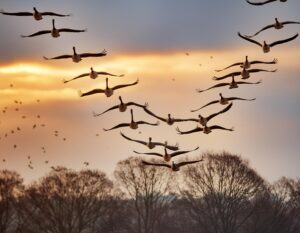Five Lessons from the Flying V
Today’s Tuesday Reading is from Rebekah Dorn, Ph.D., Senior Director of Strategy & Outreach at Florida State University. She is a MOR program alum. Rebekah may be reached at [email protected] or via LinkedIn.
I am often fascinated with geese in their “Flying V” formation and how they manage to create such a flawless shape. It amazes me how effortless they seem as they do it! However, in my area, sometimes these same birds that I was in awe of 10 minutes before are now crossing the road so slowly and holding up the traffic flow. As I wait not-so-patiently during the delays, I try to take a deep breath and reflect on the lessons we can learn from these winged companions.
The phrase “ducks fly together,” popularized by Disney’s movie Mighty Ducks in the 90s, is a clear lesson we can observe as geese fly in a perfect V formation. Studies show that this way of teamwork helps them increase their flying range by more than 70% because the uplift reduces the air friction for the birds that follow the lead bird. When a goose leaves its formation and group, the geese behind it face more drag and resistance, which makes it harder for the group to maintain the same speed and effort.
We can also learn from the geese in other ways, apart from how they fly together to increase efficiency. Geese share roles so that the same goose is only sometimes the leader. Have you ever noticed that when the front goose gets tired, it will move to the back of the group and let another goose take charge? As the former leader joins the back of the formation, it immediately benefits from the birds ahead of it. The bird does not remain the leader because it was “the leader” but shares the responsibilities when someone else could benefit the flock. Similarly, studies show that members of the flock take the lead role under different situations and circumstances, suggesting that birds use their skills and experience to benefit the overall good of the group.
Geese are loud birds that make cackling and quacking sounds to identify and support each other. There are varied reasons why geese honk at each other, such as mating and defending their territory, but researchers believe the honking is a way of telling where they are in the formation during flight. They quack to coordinate their flight pattern, find their way, stay together, and use a specific honking pattern to communicate a change in speed or direction.
Finally, I admire these birds more when I consider their loyalty to their flock through thick and thin. When a goose is injured or ill, two other geese leave the formation to assist or guard it on the ground. They remain with the injured goose until it recovers or passes away, and then the two geese rejoin their flock. I appreciate that these geese take care of each other when they are soaring and struggling.
As we reflect on the actions of these birds, here are five leadership lessons we can learn from a gaggle of geese:
- Groups that work together can achieve their end goal faster and more efficiently because of the momentum of the group work.
- When we establish an effective team, it is essential that we stick together even when things get difficult. We create synergy not in isolation but through working together as a team.
- We can share the load among the team members. Different skills and capabilities can shine when we take turns leading and empowering those around us.
- Encouragement is needed among team members. Recognize each other’s contributions and motivate those who need extra encouragement to achieve shared goals.
- Stand by team members during the good and bad times. When someone is going through a challenging time, our key role is to support and protect them until they are ready to fly again.
Ask yourself these questions: Are you working together to be an efficient team? Are you working together and letting people use their strengths to move the group forward? How are you encouraged and stuck by your team members through thick and thin? The next time you see a “Flying V,” I challenge you to reflect on how you can take these birds’ lessons and apply them to your own leadership.

How would you rate the teamwork in your most immediate work team?
Last week we asked what have you found most effective in using the idea of “so what?”
- 33% said to emphasize the relevance of benefits and outcomes.
- 27% said to deepen team understanding and sustainable focus.
- 23% said strategic justification and alignment.
- 17% said to sharpen proposals for deeper engagement and impactful outcomes.

Asking “so what?” as we did last week gets to one of the most fundamental forms of motivation: understanding why. If we can help others with this, it is a form of influence. Decades of research has found people are much more likely to do something if they understand why that something matters. What can you do to help others understand why?
- July 2025 (1)
- June 2025 (4)
- May 2025 (5)
- April 2025 (5)
- March 2025 (4)
- February 2025 (4)
- January 2025 (4)
- December 2024 (3)
- November 2024 (4)
- October 2024 (5)
- September 2024 (4)
- August 2024 (4)
- July 2024 (5)
- June 2024 (4)
- May 2024 (4)
- April 2024 (5)
- March 2024 (4)
- February 2024 (4)
- January 2024 (5)
- December 2023 (3)
- November 2023 (4)
- October 2023 (5)
- September 2023 (4)
- August 2023 (4)
- July 2023 (4)
- June 2023 (4)
- May 2023 (5)
- April 2023 (4)
- March 2023 (1)
- February 2023 (1)
- January 2023 (4)
- December 2022 (3)
- November 2022 (5)
- October 2022 (4)
- September 2022 (4)
- August 2022 (5)
- July 2022 (4)
- June 2022 (4)
- May 2022 (5)
- April 2022 (4)
- March 2022 (5)
- February 2022 (3)
- January 2022 (4)
- December 2021 (3)
- November 2021 (4)
- October 2021 (3)
- September 2021 (4)
- August 2021 (4)
- July 2021 (4)
- June 2021 (5)
- May 2021 (4)
- April 2021 (4)
- March 2021 (5)
- February 2021 (4)
- January 2021 (4)
- December 2020 (4)
- November 2020 (4)
- October 2020 (6)
- September 2020 (5)
- August 2020 (4)
- July 2020 (7)
- June 2020 (7)
- May 2020 (5)
- April 2020 (4)
- March 2020 (5)
- February 2020 (4)
- January 2020 (4)
- December 2019 (2)
- November 2019 (4)
- October 2019 (4)
- September 2019 (3)
- August 2019 (3)
- July 2019 (2)
- June 2019 (4)
- May 2019 (3)
- April 2019 (5)
- March 2019 (4)
- February 2019 (3)
- January 2019 (5)
- December 2018 (2)
- November 2018 (4)
- October 2018 (5)
- September 2018 (3)
- August 2018 (3)
- July 2018 (4)
- June 2018 (4)
- May 2018 (5)
- April 2018 (4)
- March 2018 (5)
- February 2018 (5)
- January 2018 (3)
- December 2017 (3)
- November 2017 (4)
- October 2017 (5)
- September 2017 (3)
- August 2017 (5)
- July 2017 (3)
- June 2017 (8)
- May 2017 (5)
- April 2017 (4)
- March 2017 (4)
- February 2017 (4)
- January 2017 (4)
- December 2016 (2)
- November 2016 (7)
- October 2016 (5)
- September 2016 (8)
- August 2016 (5)
- July 2016 (4)
- June 2016 (12)
- May 2016 (5)
- April 2016 (4)
- March 2016 (7)
- February 2016 (4)
- January 2016 (10)
- December 2015 (4)
- November 2015 (6)
- October 2015 (4)
- September 2015 (7)
- August 2015 (5)
- July 2015 (6)
- June 2015 (12)
- May 2015 (4)
- April 2015 (6)
- March 2015 (10)
- February 2015 (4)
- January 2015 (4)
- December 2014 (3)
- November 2014 (5)
- October 2014 (4)
- September 2014 (6)
- August 2014 (4)
- July 2014 (4)
- June 2014 (4)
- May 2014 (5)
- April 2014 (5)
- March 2014 (5)
- February 2014 (4)
- January 2014 (5)
- December 2013 (5)
- November 2013 (5)
- October 2013 (10)
- September 2013 (4)
- August 2013 (5)
- July 2013 (8)
- June 2013 (6)
- May 2013 (4)
- April 2013 (5)
- March 2013 (4)
- February 2013 (4)
- January 2013 (5)
- December 2012 (3)
- November 2012 (4)
- October 2012 (5)
- September 2012 (4)
- August 2012 (4)
- July 2012 (5)
- June 2012 (4)
- May 2012 (5)
- April 2012 (4)
- March 2012 (4)
- February 2012 (4)
- January 2012 (4)
- December 2011 (3)
- November 2011 (5)
- October 2011 (4)
- September 2011 (4)
- August 2011 (4)
- July 2011 (4)
- June 2011 (5)
- May 2011 (5)
- April 2011 (3)
- March 2011 (4)
- February 2011 (4)
- January 2011 (4)
- December 2010 (3)
- November 2010 (4)
- October 2010 (4)
- September 2010 (3)
- August 2010 (5)
- July 2010 (4)
- June 2010 (5)
- May 2010 (4)
- April 2010 (3)
- March 2010 (2)
- February 2010 (4)
- January 2010 (4)
- December 2009 (4)
- November 2009 (4)
- October 2009 (4)
- September 2009 (4)
- August 2009 (3)
- July 2009 (3)
- June 2009 (3)
- May 2009 (4)
- April 2009 (4)
- March 2009 (2)
- February 2009 (3)
- January 2009 (3)
- December 2008 (3)
- November 2008 (3)
- October 2008 (3)
- August 2008 (3)
- July 2008 (4)
- May 2008 (2)
- April 2008 (2)
- March 2008 (2)
- February 2008 (1)
- January 2008 (1)
- December 2007 (3)
- November 2007 (3)
- October 2007 (3)
- September 2007 (1)
- August 2007 (2)
- July 2007 (4)
- June 2007 (2)
- May 2007 (3)
- April 2007 (1)
- March 2007 (2)
- February 2007 (2)
- January 2007 (3)
- December 2006 (1)
- November 2006 (1)
- October 2006 (1)
- September 2006 (3)
- August 2006 (1)
- June 2006 (2)
- April 2006 (1)
- March 2006 (1)
- February 2006 (1)
- January 2006 (1)
- December 2005 (1)
- November 2005 (2)
- October 2005 (1)
- August 2005 (1)
- July 2005 (1)
- April 2005 (2)
- March 2005 (4)
- February 2005 (2)
- December 2004 (1)